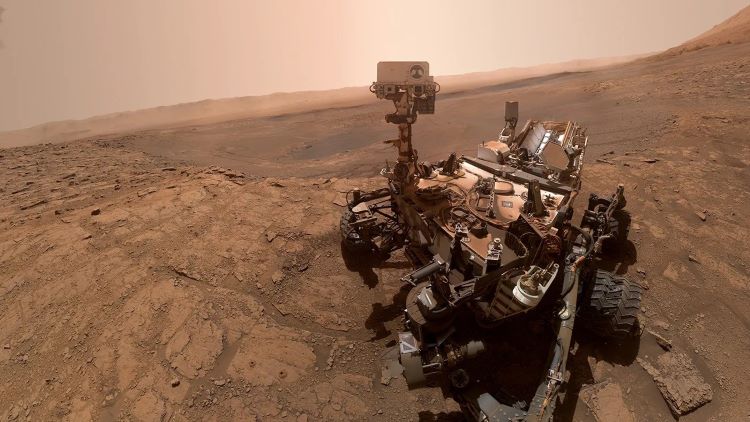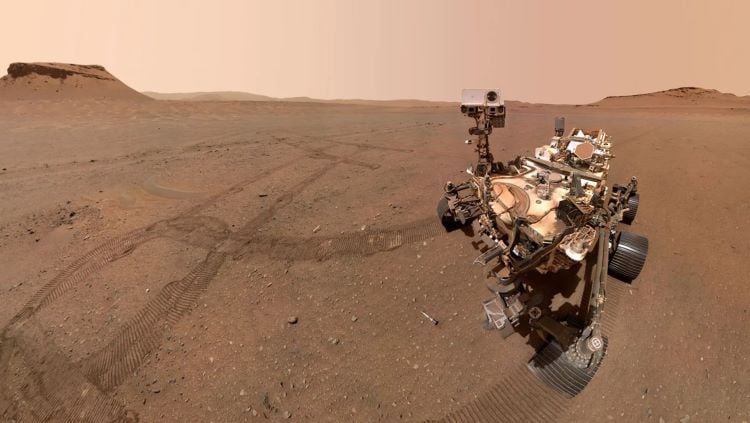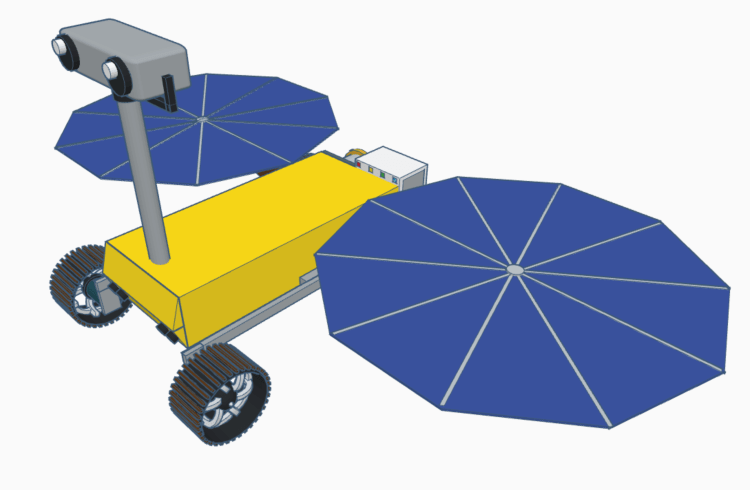A recent study presented at the 55th Lunar and Planetary Science Conference (LPSC) discusses the Mars Astrobiology, Resource, and Science Explorers (MARSE) mission concept and its Simplified High Impact Energy Landing Device (SHIELD), which offers a broader and cheaper method regarding the search for—past or present—life on the Red Planet, specifically by using four rovers at four different landing sites across Mars' surface instead of just one-for-one. This concept comes as NASA's Curiosity and Perseverance rovers continue to tirelessly explore the surface of Mars at Gale Crater and Jezero Crater, respectively.
Here, *Universe Today* discusses the MARSE mission concept with the study's sole author, Alex Longo, who is a MS student in the Department of Earth, Marine and Environmental Sciences at the University of North Carolina at Chapel Hill, regarding the motivation behind MARSE, how the landing sites were chosen, significant implications, current work being conducted, and next steps for MARSE becoming an actual mission. Longo draws on his ten-plus years of experience finding landing sites on Mars, along with having several publications under his belt, including an assortment of scientific abstracts, papers, and a Kindle book. So, what was the motivation behind the MARSE mission concept?
"The overarching goal of the MARSE concept study was to reduce the cost of access to the surface of Mars," Longo tells *Universe Today*. "Flagship-class rovers, such as Curiosity and Perseverance, are extremely capable vehicles. The caveat is that, since they cost over a billion dollars apiece, we can only visit one or two sites on Mars every decade. Like Earth, Mars is an astoundingly diverse planet. Using satellites in orbit, we have mapped a variety of ancient environments which may have been habitable in the distant past. However, the resolution of orbital imagery and spectra are limited, and they sometimes fail to predict what a field geologist (or, in the case of Mars, a rover controlled by geologists) will discover on the ground. Even on Earth, finding early biosignatures is difficult, and even with comparatively little weathering and erosion, I would not be surprised if the same is true on Mars. MARSE was intended to present one possible solution which would allow planetary scientists to explore more sites on Mars within a realistic budget."
The car-sized Curiosity rover landed in Gale Crater on August 6, 2012, with its mission website displaying that Curiosity has traveled a total of 31.27 kilometers (19.43 miles) as of January 27, 2024, having far surpassed its primary mission timeline of one Martian year, or 687 Earth days. Gale Crater was chosen as the landing site due to a multitude of evidence that it once held liquid water at some point in Mars' ancient past, as scientists estimate that Gale Crater was formed from an impact between approximately 3.5 to 3.8 billion years ago. During its time in Gale Crater, Curiosity has used its suite of scientific instruments to identify evidence of past liquid water within Gale Crater and evidence that Mars once contained the building blocks for life, including carbon, oxygen, nitrogen, phosphorus, and sulfur.
The car-sized Perseverance rover landed in Jezero Crater on February 18, 2021, with its mission website displaying that Perseverance has traveled a total of 25.113 kilometers (15.604 miles) as of March 28, 2024. While Perseverance and Curiosity have similar designs, the main upgrade has been the delivery of the Ingenuity helicopter to Mars, which became the first robotic explorer to achieve a powered flight on another world and accomplished dozens of flights before being permanently grounded after damaging one of its rotor blades on what would be its final landing in January 2024. Like Gale Crater for Curiosity, Jezero Crater was chosen as the landing site for Perseverance due to strong evidence that it once held a massive body of liquid water, which is made evident from the enormous fan-delta deposit that was the likely entry point for the liquid water billions of years ago. During its time in Jezero Crater, Perseverance has used its suite of scientific instruments to identify ancient volcanic rocks, sediments from an ancient lakebed, converted carbon dioxide (the primary atmospheric constituent of Mars) to oxygen, and even used its powerful microphones to record the sounds of Mars. Given the incredible science conducted by Curiosity and Perseverance, what are the most significant implications for the MARSE mission?
"The most significant ramification of this trade study is that it should be possible to build a small rover capable of characterizing an unexplored site on Mars," Longo tells *Universe Today*. "There have been several proposals for cheap Mars landers, such as SHIELD. MARSE demonstrates that it may be possible to deliver useful scientific payloads with these landers. Each MARSE rover weighs just 15 kilograms and is about the size of a microwave oven. If we can determine how to land similar rovers on Mars, that would help proliferate and democratize Mars exploration. We are already seeing a similar paradigm shift in lunar exploration thanks to the Commercial Lunar Payload Services (CLPS) program."
While Curiosity and Perseverance have successfully explored their respective landing sites in great detail, the cost of each mission was in the billions of dollars (Curiosity: ~$2.5 billion, Perseverance: ~$2.7 billion). Therefore, the cost alone only allows for one rover per mission, and their landings occurred almost seven years apart. As noted, one of the objectives of the MARSE mission concept is to land four rovers at four separate landing sites, which are Columbia Hills, Milankovi? Crater, Mawrth Vallis, and Terra Sirenium, with Coumbia Hills being the landing site for the Spirit rover during its mission from 2004 to 2010, and the others having never been explored by landers or rovers. But how were the landing sites chosen and are other landing sites being considered?
Longo tells *Universe Today*, "The four landing sites are not an exclusive list. We just wanted to illustrate the range of investigations which can be conducted with this approach. All four of the listed sites have been highlighted in peer-reviewed papers and prior landing site studies, so we know that they have high scientific potential."
Longo continues by telling *Universe Today* that SHIELD will be designed to "land at any flat site on Mars below the datum (0 km of elevation on Mars; the equivalent of sea level on Earth), so you could readily swap one or more of them out for locations of your choice", with Longo noting that one of his personal favorite landing sites would be inside Valles Marineris, which is the largest and deepest canyon in the solar system. Longo discusses the years-long research by Dr. Steven Ruff at Arizona State University, who conducted analog studies comparing hot spring deposits at Columbia Hills on Mars to similar features at the El Tatio hot spring in Chile, concluding that microbial communities could thrive at these locations.
As noted, Curiosity and Perseverance landed on Mars almost nine years apart, 2012 and 2021, respectively, but their respective missions had been in the works almost an entire decade earlier. Both rovers are part of NASA's Mars Exploration Program, with the Curiosity rover mission having been approved in 2003 and the Perseverance rover mission having been announced in 2012. Once approved, it takes NASA years to design and build each rover, ensuring every aspect of their systems is functioning at their fullest potential before being delivered and loaded onto the launch vehicle. This includes tests designed to analyze the rovers' endurance, exposure to harsh environments, and longevity, and many others. Therefore, if a MARSE mission were to get the green light, it could still be almost a decade of designs, builds, and tests before their microwave-sized rovers touch the surface of Mars. So, what are the next steps in terms of MARSE being approved for an actual mission?
"Regrettably, the future of MARSE and SHIELD is uncertain," Longo tells *Universe Today*. "This concept was developed with the support of the SHIELD team at JPL, led by Lou Giersch and Nathan Barba. They were doing phenomenal, cutting-edge work, and I was grateful for the opportunity to work with them. Unfortunately, JPL was forced to implement massive budget cuts and layoffs last month due to uncertainty over the future of the Mars Sample Return mission, which accounts for the majority of the center's budget. Because JPL's future priorities are in flux, we have placed the development of the MARSE concept on hold."
While uncertainty looms for the MARSE mission, it's important to note that space exploration missions often take decades to go from a simple concept to real hardware, and then several more years until it's launched. This is noted by the Curiosity and Perseverance rover missions, as it took almost a decade from the time each was approved until they landed on Mars. Moreover, it is not uncommon for mission proposals to take several attempts before they're approved, as NASA has very stringent criteria for approving missions, including cost, timelines, science objectives, and long-term implications for science. Despite the outlook, this has not deterred Longo from continuing his work for the MARSE mission concept.
"Developing a mission concept is a rewarding experience, and it was a privilege to work on this concept with the SHIELD team," Longo tells *Universe Today*. "Even if it happens a decade from now, I hope that someone will eventually implement a low-cost, multi-rover Mars geology and astrobiology mission. Following the completion of Mars Sample Return, the next logical steps in Mars exploration are to explore more of the planet, to develop a better understanding of its history, and to learn what Mars can teach us about our own planet's past. If we want to have a thriving space program, we need to be creative and embrace bold ideas, and I love working with the scientists and engineers who are doing just that."
Will the MARSE mission get to explore the Red Planet in the coming years and decades? Only time will tell, and this is why we science!
As always, keep doing science & keep looking up!
 Universe Today
Universe Today





